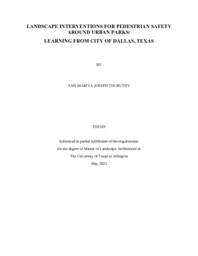| dc.description.abstract | Urban parks and their immediate surroundings provide access to nature in urbanized areas. However, they can also be crime hotspots if not properly kept or monitored or provide a safe environment for positive activities (Jones & Robinson, 2008). The local community respects a safe and secure neighborhood urban park as proximity to green spaces (McCormack et al., 2010), which enhances living quality (Iqbal & Ceccato, 2015). Nevertheless, a neighborhood urban park and its context have a negative impact on the quality of life if they cater to criminal activity. Crime rates have increased in urban public parks and buffer zones (Groff & McCord, 2011). In today's society, urban public parks and their surrounding safety are becoming a severe issue (Kula, 2015). As a result, authorities are always looking for strategies to help them avoid crime (Telep & Weisburd, 2012). Crime Prevention Through Environmental Design (CPTED) is a widely used global concept for preventing crime in various settings (Cozens, Saville, & Hillier, 2005). However, CPTED's basic concepts establish a procedure for recognizing problems, evaluating the physical environment, and identifying ways to eliminate or limit possibilities for crime (Zahm, 2011).
This thesis aims to understand and redesign the environment that contributes to crime by examining where crime and criminal activities occur in and around urban parks in the city of Dallas. The research focuses specifically on analyzing and redesigning State Thomas Neighborhood due to the documented crime hotspots surrounding Griggs Parks. This study aims to provide an evidence-based approach to analyzing and redesigning urban parks and their surroundings to address safety.
This design master thesis follows quantitative approaches to study and assess crime and design in relation to urban parks and their surroundings (Deming & Swaffield, 2011; & Guinn, 2013). This research followed four steps. First, the crime data is collected from the City of Dallas Open Data 2022 (Dallas Open Data, 2022). Then, Geographic Information System (GIS) is utilized for crime mapping based on the collected data to pinpoint hotspots in and around the urban parks in the city. Second, the study adopted hotspot and network analysis using GIS to select one of the binding sites (State Thomas Neighborhood) to examine the issues and offer design strategies. Thirdly, the CPTED principles and other relevant literature are documented to inform design strategies. Fourth, critical case studies are adopted and analyzed using Marcus and Francis' (1998) People Place criteria to understand better how the world has approached similar situations. Lastly, design recommendations are made based on the research finding, site inventory, and analysis. The research illustrated that safety could be an issue even in well-designed parks and neighborhoods such as the State Thomas and Griggs Park if the proper design, maintenance, and upkeep strategies are not followed.
In conclusion, this research shows that evidence-based design strategies can enhance the safety of urban parks and their environments and provide safe and secure neighborhoods for people to utilize, starting from the State Thomas neighborhood. The research also shows that CPTED principles and global design methodologies can be considered here for designing a safer neighborhood in the City of Dallas. Although this research was not conclusive if urban parks may or may not be the reasons for an area to be unsafe, assessing the geospatial distribution of crime through hotspots analysis may yield the park's relationship to its context to propose an urban park region that is safer for people to enjoy. | |


